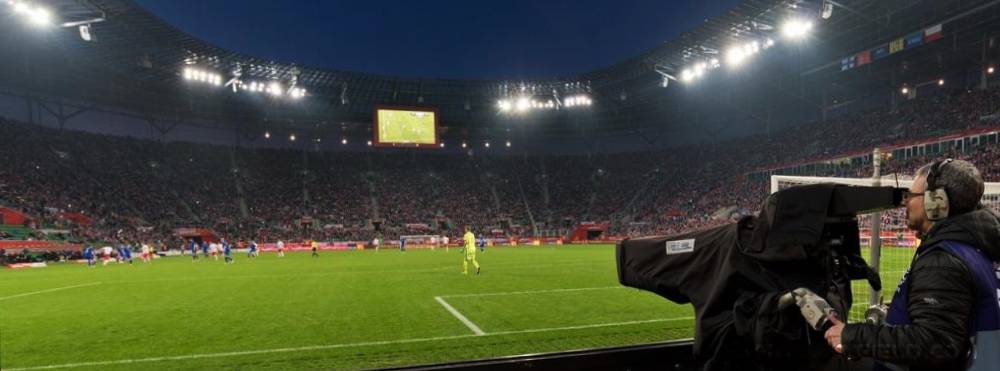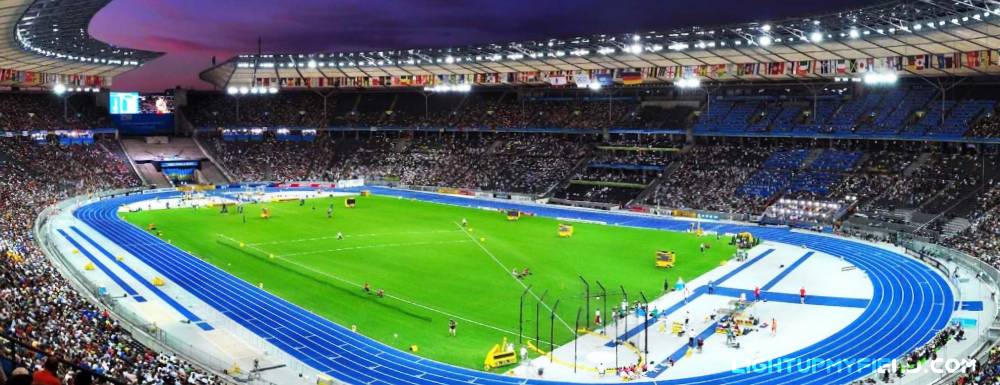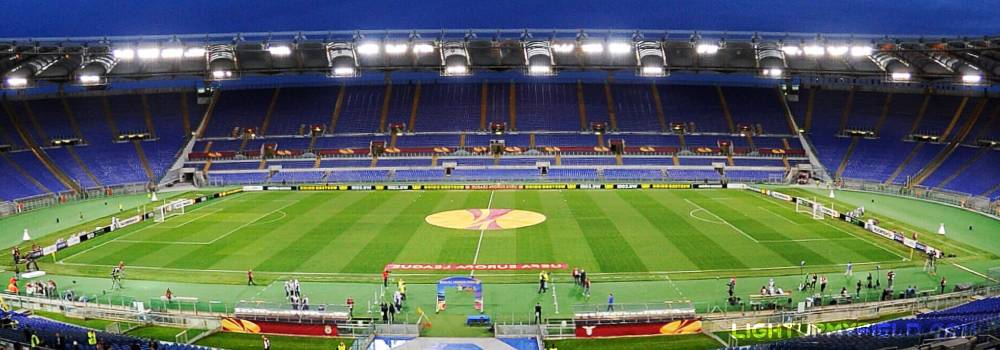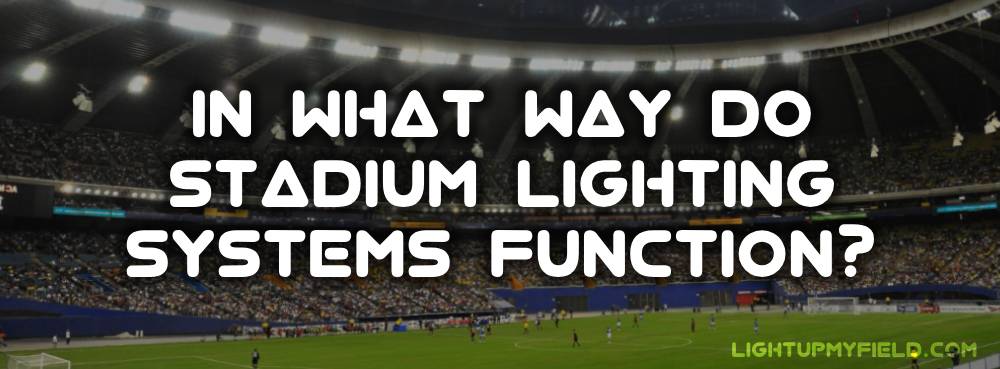When you walk into a stadium for a night game or a late-evening concert, the massive lights flooding the entire venue with bright, even illumination feel like magic. But behind that glow is a combination of engineering, design, and technology working together. Stadium lighting systems are not just about brightness—they’re about creating a visual experience that works for both the live audience and those watching from home.
So, in what way do stadium lighting systems function? Let’s dig deeper into why understanding this matters, what makes up these systems, how the parts work together, and what needs to be considered when installing new lighting setups.
Table of Contents
ToggleWhy Do We Need to Understand How Does Stadium Lighting Work?
More Than Just Brightness: Why Lighting Matters
Lighting in a stadium isn’t as simple as flipping on a few massive lamps. It affects player performance, spectator experience, and even global broadcast quality. Picture a football match watched by millions worldwide—if the lighting is patchy or too dim, not only does it ruin the TV viewing experience, but it can also lead to serious safety concerns for players. Poor illumination can cause misjudged passes, delayed reactions, and even injuries on the field.

The Scale of Stadium Lighting
A typical professional stadium needs 300 to 500 high-powered fixtures to achieve proper illumination. Each fixture can run at 1,000 to 2,000 watts, which means a single hour of full lighting could consume up to 1,000 kilowatt-hours or more. If a stadium hosts 40 night events in a season, that’s easily 40,000 kWh or more, translating to tens of thousands of dollars in electricity costs if managed poorly.
To put that into perspective, an average household uses about 10,000 kWh in an entire year—so one stadium could burn through four times that in just a few weeks of games. That’s how massive the energy demand is, and why understanding these systems is more than just a technical detail—it’s tied directly to operational budgets and sustainability goals.
How Modern Tech Changes the Game
Traditional metal halide lamps, once the standard, consume enormous amounts of power and require warm-up times of 15 to 30 minutes. Compare that to LED floodlights, which not only turn on instantly but also cut energy use by 60–70%. That means if your old system used 500,000 kWh annually, an LED upgrade could bring that down to 150,000–200,000 kWh, saving hundreds of thousands of dollars over a few years.
Why Knowledge Equals Better Performance and Lower Costs
So, understanding how stadium lighting works isn’t just about “keeping the field bright.” It’s about precision, efficiency, and experience. When lighting is well-designed and properly maintained, glare is reduced, shadows are eliminated, and the field looks vibrant both for fans in the stands and those watching on 4K screens at home. Plus, better understanding means smarter energy management, longer fixture life, and lower carbon emissions—which matters when large venues are trying to go greener.
The Constituent of Stadium Lighting System
A stadium lighting setup is far more complex than just hanging a few massive lamps around the field. It’s an interconnected system made up of multiple components that work together to deliver uniform brightness, consistent color quality, and reliable operation. Understanding these parts is key to appreciating how the entire system performs.
Light Fixtures – The Heart of the System
The most visible part of any stadium lighting system is, of course, the light fixtures. These are the actual sources of illumination. Historically, metal halide lamps were the dominant choice because they produced strong, white light. However, they came with downsides: a warm-up time of 15–30 minutes, a relatively short life span of around 10,000 hours, and significant energy consumption.
Modern stadiums now almost exclusively use LED floodlights, and for good reason. LEDs offer a life expectancy of 50,000 to 100,000 hours, meaning they can last five to ten times longer than metal halides. They also provide instant on/off capability, better color rendering index (CRI) above 80, and allow for dimming options that weren’t possible with older tech. This translates into reduced maintenance costs and up to 70% energy savings. For example, a single 1,500-watt metal halide fixture replaced with an equivalent LED fixture can save 900 watts of power, which adds up when you have 400 to 500 fixtures in a stadium.

Poles and Mounting Structures – Getting the Angles Right
The lights themselves need to be positioned with precision to avoid shadows and ensure even coverage across the playing surface. This is where mounting structures come into play. Most stadiums use tall steel towers or catwalk systems integrated into the roof.
A standard professional football stadium typically requires four to eight lighting towers, each standing between 30 and 50 meters tall. Each tower can support 40 to 100 fixtures, depending on the illumination requirements and the type of sport. The mounting angle is calculated carefully using photometric studies to avoid glare and dark spots, which is especially crucial for HDTV and 4K broadcasts.
Electrical System – Powering the Beast
A stadium lighting system draws a massive amount of electricity, and the electrical infrastructure needs to handle this load safely and efficiently. For a large stadium, total lighting power demand can easily exceed 1 megawatt during full operation. The electrical system includes high-voltage wiring, transformers, circuit breakers, and power distribution panels that feed energy to each lighting tower.
Because lighting is often the single largest energy consumer during events, stadiums are increasingly integrating energy monitoring systems that track usage in real time. Proper design ensures the system can handle peak loads without voltage drops or outages, which could disrupt a game and cause huge financial and reputational losses.
Control System – Smarter Lighting Management
Gone are the days when stadium lighting was controlled by a simple switch. Modern installations rely on advanced control systems that give operators flexibility and precision. These systems allow for dimming control, color-changing effects, and programmable lighting scenes for different events, such as a soccer match, a concert, or a pre-game show.
Smart lighting controls can also be integrated with IoT (Internet of Things) technology, enabling remote operation through computers or mobile apps. Some systems even use AI algorithms to optimize lighting for energy efficiency and uniformity. For example, the operator can set schedules so that lights power up gradually before an event and automatically dim after the crowd leaves, saving thousands of kilowatt-hours per season.
Backup Power – The Safety Net
Imagine the lights going out in the middle of a championship game broadcasted to millions worldwide. It would be more than just embarrassing—it could cause game delays, security issues, and even contractual penalties for broadcasters. That’s why every professional stadium lighting system includes redundant power sources, such as diesel generators or uninterruptible power supplies (UPS).
Backup systems are designed to take over within seconds of a primary power failure, ensuring that at least partial lighting remains active until full illumination can be restored. For major venues, backup capacity typically ranges from 500 kW to 2 MW, enough to keep the essential systems, including lighting, operational during a blackout.
How Do Each Constituent Function With Each Other?
Building a stadium lighting system is not just about installing lights, poles, and wires—it’s about making all these elements work in perfect sync. A well-designed system ensures uniform illumination, energy efficiency, and reliable performance during high-stakes events. Let’s break down how these components interact as one integrated solution.
It All Starts with Design and Calculation
The coordination begins long before a single light is installed. Engineers start with photometric calculations to determine the required lux levels based on the sport and size of the venue. Lux measures how much light reaches the playing surface.
- For example, FIFA standards call for about 500 lux for training grounds, 750–1,000 lux for standard matches, and up to 2,000 lux for stadiums hosting HD or 4K broadcasts.
- A large venue, like a football stadium, might need over 1 million lumens of total output to achieve these standards.
These calculations dictate the number of fixtures, their wattage, and their mounting angles. Without this stage, the lighting could end up uneven, leaving dark patches that compromise play and broadcast quality.
Precision Aiming of Fixtures

Once installed, the fixtures aren’t just pointed randomly. Each floodlight is angled with millimeter accuracy to cover specific zones of the field without causing glare for players or fans. For instance, off-axis aiming is often used so the light beams overlap slightly, creating uniform brightness without sharp shadows.
This precision is also vital for cameras. With modern HDTV and 4K broadcasting, uneven lighting can ruin picture quality, create flicker, or distort colors. That’s why fixtures and cameras are often calibrated together during final testing.
Control System as the Brain
The control system ties everything together. It’s the brain that operators use to manage lighting scenes, adjust brightness levels, and even activate dynamic effects for concerts or ceremonies. Advanced setups can create different profiles:
- Full match mode for maximum brightness
- Training mode with reduced power to save energy
- Event mode for colorful light shows
Some systems integrate with DMX or DALI protocols, which are widely used in theatrical lighting, giving stadiums the ability to run synchronized shows with music and video.
Power and Backup – Keeping It Reliable
All this high-tech coordination would mean nothing without a robust electrical system. Power flows from transformers and distribution panels to the towers, controlled by circuit breakers designed for high-load operation. If one circuit trips, backup circuits or automatic transfer switches immediately reroute power, preventing a blackout.
For added safety, most stadiums have diesel generators or UPS systems that can deliver anywhere from 500 kW to 2 MW within seconds. This ensures the game continues even if the main grid goes down.
Smart Monitoring for Real-Time Feedback
Modern stadiums take it a step further with IoT-enabled lighting systems. Sensors and software provide real-time data on energy usage, fixture temperature, and operational health. Operators can monitor performance from a control room—or even a mobile device—and schedule maintenance before problems occur. For example, if one LED module starts to degrade, the system can flag it for replacement before it fails during a big game.
The End Result: Perfect Synchronization
When all these elements—fixtures, poles, power, controls, and software—work together, the result is seamless lighting performance. The field remains evenly lit, cameras capture crystal-clear broadcasts, and players enjoy consistent visibility that reduces errors and injuries. For fans, it creates an unforgettable experience whether they’re in the stands or watching from home.
Points to Note When Installing the New Stadium Lighting System
Installing a stadium lighting system isn’t just another facility upgrade—it’s a major investment and a technical challenge that impacts energy consumption, fan experience, and broadcasting quality for years to come. The cost alone underscores its scale: depending on whether you’re retrofitting or building from scratch, expenses can range from $500,000 to well over $2 million for a large venue. For world-class stadiums hosting international events, that figure can easily climb beyond $5 million when you include advanced control systems and show lighting capabilities.
Careful planning ensures you don’t just meet today’s needs, but also keep the system future-ready.
Choosing the Right Light Source
The first decision is the type of lighting technology. While metal halide lamps once dominated, the shift to LED lighting has become nearly universal—and for good reason. LEDs deliver:
- Up to 70% energy savings compared to traditional lamps
- Lifespans of 50,000–100,000 hours (vs. ~10,000 for metal halide)
- Instant on/off control and no warm-up time, which is vital for broadcasts and halftime shows
- High Color Rendering Index (CRI), which makes the field look vibrant on HD and 4K cameras
For context, replacing 400 metal halide fixtures (1,500 W each) with LED equivalents can cut annual electricity use by 300,000–400,000 kWh, saving tens of thousands of dollars every season.
Perfecting Angles and Placement
Lighting isn’t just about brightness; it’s about uniformity and precision. Misaligned fixtures can lead to glare for players, shadow zones on the field, and uneven brightness that looks terrible on broadcast. Professional installations use computer-based aiming diagrams to achieve lux uniformity ratios as low as 1.2:1, meaning light distribution is nearly even across the entire playing surface.
Mounting heights also matter: towers typically range from 30–50 meters, and each fixture’s beam angle is carefully chosen to cover specific zones without overlap or blind spots.
Power Infrastructure and Load Management
Stadium lighting is a high-demand system. A large venue with 400–500 LED fixtures at 1,000 watts each can draw 400–500 kW at full load. The electrical system must handle this without voltage drops or tripping breakers. That means proper transformers, distribution panels, and surge protection are a must.
Many stadiums now integrate energy management systems that track real-time consumption and optimize lighting schedules, reducing operating costs and extending equipment life.
Weather Resistance and Durability
Outdoor stadiums face harsh environments: rain, snow, wind, dust, and extreme temperatures. This is why fixtures must have an IP65 or higher rating, which ensures they are resistant to water and dust ingress. Corrosion-resistant materials, like powder-coated aluminum, are also common for long-term durability. Investing in weatherproofing prevents costly repairs and replacements down the line.
Building for the Future
Technology moves fast. Features like adaptive lighting, dynamic color shows, and IoT-enabled controls are becoming standard in premium venues. When planning a new system, ensure it’s modular and software-upgradable. That way, you can add advanced capabilities—such as AI-based brightness optimization or interactive fan light shows—without tearing everything down and starting over.
What About Maintenance and Long-Term Performance?
A well-installed lighting system can last for 10–15 years or more, but it doesn’t mean you can just set it and forget it. Routine maintenance keeps performance and safety standards high.
Regular Inspections and Cleaning
Fixtures should be inspected for dirt buildup, alignment shifts, or signs of wear. Even a thin layer of dust can reduce light output by 5–10%, which adds up over time and can affect broadcast quality.
Predictive Maintenance with Smart Monitoring
Modern LED systems often come with remote monitoring software, allowing operators to check fixture status, energy use, and temperature in real time. Many platforms send alerts if a component starts to fail, so you can fix issues before they cause outages during a big game.
For example, if a driver overheats, the system can flag it immediately, avoiding a sudden blackout on one side of the field.
Adding Dynamic Features
Today’s stadium experience is about more than just visibility; it’s about entertainment. Color-changing LEDs and programmable light sequences for halftime shows or post-game celebrations are becoming standard. These features need occasional software updates and calibration to keep everything smooth and synchronized.
Wrapping It All Up
Stadium lighting systems are much more than just giant bulbs on tall poles. They’re an interconnected network of lights, power, and controls designed to deliver uniform brightness, visual clarity, and energy efficiency. From fixture selection to maintenance strategies, every detail counts in creating the perfect atmosphere for players and fans alike.
The next time you’re at a night game or watching one on TV, take a moment to appreciate the technology overhead. It’s a blend of engineering precision and smart design, all working behind the scenes to make those bright moments possible.

